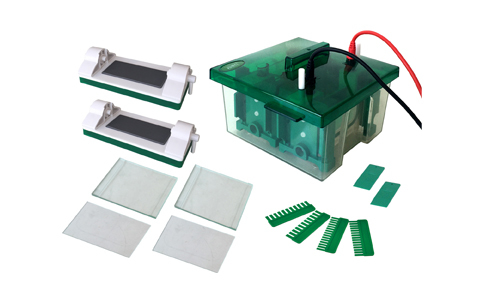Gel electrophoresis is a laboratory technique used in genetics to separate mixtures containing DNA, RNA and other proteins according to their respective molecular charge and size. The DNA, RNA, or proteins to be separated in this method are executed through a gel containing small pores. The molecules are conducted through the gel by an electric field.
Horizontal gel electrophoresis
Horizontal gel electrophoresis uses the basic theory for the separation of DNA, RNA, or protein molecules according to their respective molecular size and charge. In this technique, the gel is present in a horizontal orientation and is immersed in a buffer that is continuous. The agarose gel is used to separate the gel carton into two compartments. One end of the gel box contains an anode, the other end contains a cathode. When a current is applied, the buffer used in this technique allows the creation of a load gradient. When load is applied, the gel tends to warm.
The buffer also functions as a coolant, which maintains the temperature at optimal levels. Recirculation of the executing buffer prevents the formation of a pH gradient. A discontinuous buffer system cannot be used in horizontal gel electrophoresis since the two compartments of the gel system are connected to the operating buffer.
For horizontal gel electrophoresis, acrylamide cannot be used because the gel box is exposed to oxygen. Due to the presence of oxygen, the polymerization of acrylamide is inhibited, interfering with the formation of the gel. Horizontal gel electrophoresis is a non-stress method used in the separation of DNA and RNA.
Vertical gel electrophoresis
The vertical gel electrophoresis technique works according to the primary theory of gel electrophoresis but is considered to be more complex than the horizontal gel electrophoresis method. This technique uses a discontinuous buffer. A cathode is located in the upper chamber, and the anode is located in the lower chamber. Electrodes in each compartment provide the required electrical field. A thin layer of gel is poured between the two mounted glass plates. Thus, the top of the gel is immersed into the upper chamber, and the bottom of the gel is immersed into the chamber of the lower. Once current is applied, a small portion of the tampon is moved into the lower chamber from the upper chamber through the gel.
In vertical gel electrophoresis, the tampon only flows through the gel. This allows for precise control of the voltage gradient during the separation stage. Acrylamide gel may be used because compartments are not exposed to atmospheric oxygen. Due to the smaller pore size of the acrylamide gel, a precise separation can be achieved with higher resolution.
At Kalstein we are MANUFACTURERS, that is why you can BUY excellent electrophoresis systems for your laboratory at excellent PRICES. That’s why we invite you to take a look at our equipment available in the “Products” menu. HERE

